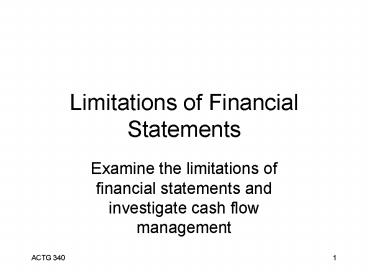Limitations of Financial Statements PowerPoint PPT Presentation
1 / 13
Title: Limitations of Financial Statements
1
Limitations of Financial Statements
- Examine the limitations of financial statements
and investigate cash flow management
2
Limitations of Financial Statements
- Subject to earnings manipulation
- Use of estimates and allocation
- Use of historical costs
- Omission of resources and costs
- Delay in providing information
3
Nature of Product Life Cycle (1)
- Introduction
- Lack of Capital
- Poor cash flow
- Learning the business
- Poor financial information and inaccurate
predictions - Possibly no profit
- Growth
- High growth in sales and profits
- Highly strained capital
- Potential poor growth management (???)
- Likely cash flow problem to support growth
- High demand for financial information
4
Nature of Product Life Cycle (2)
- Maturity
- Strong Capital
- Positive cash flow
- Experienced management
- Timely and accurate financial information
- Sustaining market shares
- Decline/Renewal
- Declining market shares
- Adequate capital
- Underutilized financial information
- Developing new products
5
Product Life Cycle
Financing CF
0
Investing CF
Op. CF
Intro Growth Maturity Decline
6
Product Life Cycle Effects
- Introduction low profitability, does not
directly suggest negative operating cash flow - Growth Stage
- growth rate of sale is not necessarily equal to
an increase in net incomewhy? - Growth firms often experience poor cash flow
management (working capital)sustainable growth - Maturity Stage less investment opportunity,
sustaining market share, invest to maintain,
replace, and renew Property plant and equipment
7
Cash Flow Analysis gt Issues and Concerns
- Interpretation of negative cash flow
- Poor performance?
- Poor working capital management?
- Both?
- Acquisition/disposal of fixed assets
- Disposal upgrading or liquidating?
- Acquisition renewal or expansion
- New Debts
- Debt issued refinancing or expansion
- Overall risk and type of debt
- New Equity issued
- Financing expansion or retiring debt
8
Cash Flow Analysis gt Issues and Concerns gt
Management
- Manage extra cash wisely, cash reserves may be
costly - Prepare a monthly cash budget
- Promote cash sales (discounts)
- Keep close track of cash expenditures, daily
deposits.
9
Cash Flow Analysis gt Management gt Accounts
Receivable
- Take payment in advance whenever possible
- A/R management includes
- Partial payment upfront
- Credit history check
- Late penalty charge
- Increases in sales with liberal credit policy
must outweigh potential increases in bad debt - Sell or factor receivables
- Late Paying Customers
- Learn why
- Negotiate to acquire cash
- Collection agency
10
Cash Flow Analysis gt Management gt Inventory
- Be aware of slow-moving inventory
- Maintain low inventory levels
- Just in Time
- Economic Order Quantity
- Reorder point
- Know the market demand, seasons, technology
- Focus on high margin products, minimize loss
leaders - Subcontract internally costly processes, payroll
MUST be paid - Free lance to minimize benefit costs
11
Cash Flow Analysis gt Management gt PPE
- Lease rather than buy new assets
- Sell and lease backed fixed assets that are
currently owned - Rent out unused spaces
- Sell unused/obsolete assets (holding costs money)
- Subcontract facilities in times of excess capacity
12
Leases
- In some cases it is more advantageous to lease an
asset than to borrow money to purchase it. The
lessee can conserve cash (no large cash outlay) - Should the right to use PPE be reported as an
asset? - Should obligations (lease contracts) be a
liability? - Are all leases the same?
- Operating lease Not required to record an asset
or a liability off-balance sheet financing - Capital lease required to record the lease as
an asset and the future payments as liabilities - Transfer of ownership at the end of the lease
term - Bargain purchase at the end of the lease term
less than fair value - Lease term is greater than 75 of the useful life
- Present value of the minimum lease payments is
90 or more than the fair market value of the PPE
13
Cash Flow Analysis gt Management gt Liabilities
- Dont pay checks and bills before they are due
- Negotiate with suppliers and other creditors for
discounts, and time before it is necessary - Refinance long-term debt to take advantage of
lower interest rates (cost/benefit) - Avoid government conflicts (pay taxes, medicare,
sales tax, etc on time)

